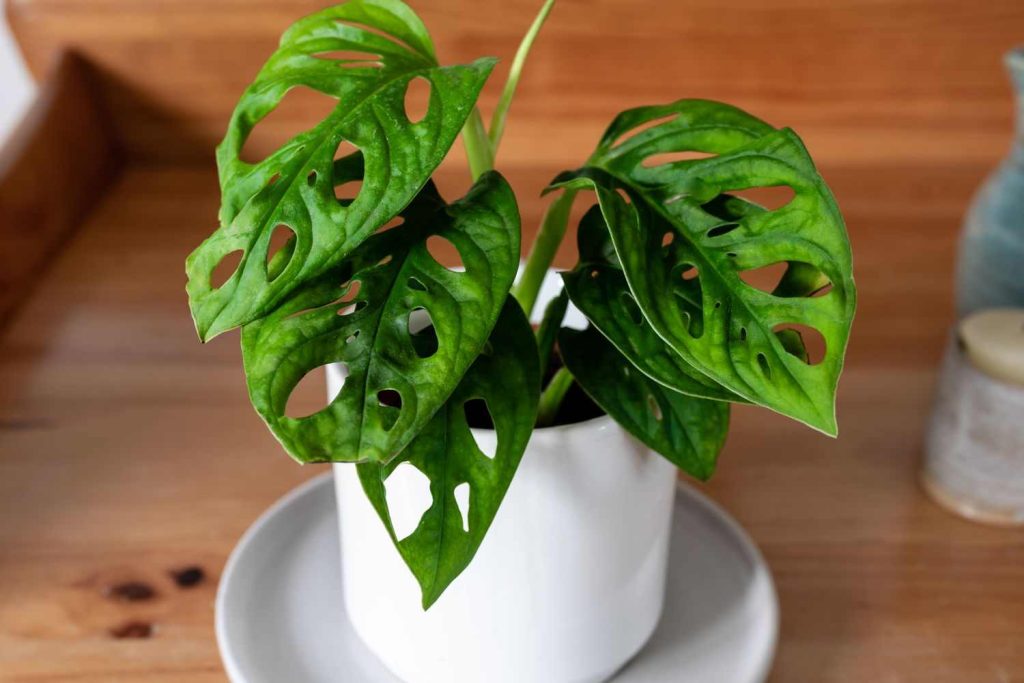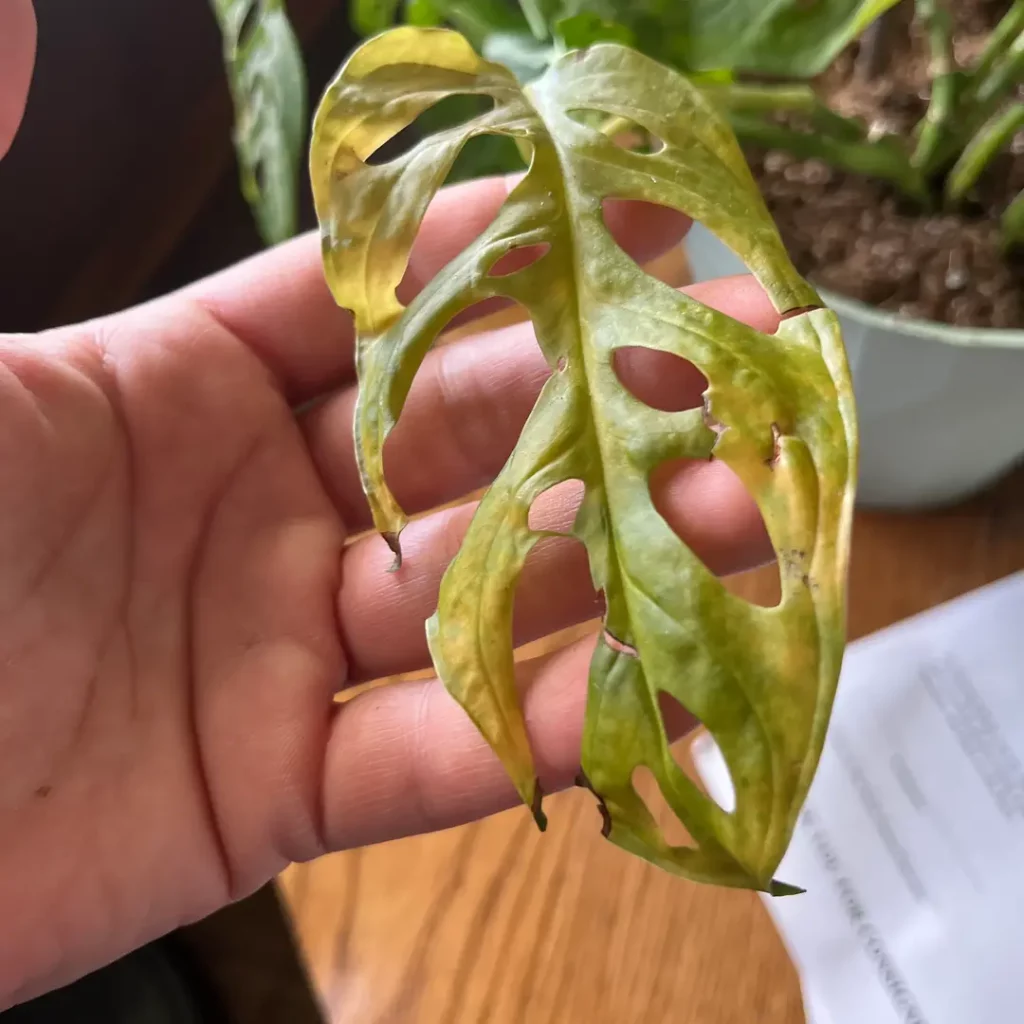Growing Swiss cheese plants, scientifically known as Monstera deliciosa, can be a perplexing yet rewarding endeavor for plant enthusiasts. With their iconic fenestrated leaves resembling slices of Swiss cheese, these tropical vines add a burst of exotic charm to any indoor space. To care for them effectively requires a delicate balance of light, water, and nutrients. Understanding their growth patterns, such as their tendency to climb when provided with support, is essential. Additionally, managing their size and providing proper drainage are crucial factors in fostering healthy growth. Mastering the art of nurturing Swiss cheese plants promises a lush and vibrant addition to your botanical collection. Plants Fiesta has done a complete in depth research on Swiss Cheese plants and written down everything about it below, let’s explore.
Swiss Cheese Plants Characteristics
| Characteristic | Description |
|---|---|
| Common Name | Swiss cheese plant, Swiss cheese vine, five holes plant |
| Botanical Name | Monstera adansonii |
| Family | Araceae |
| Plant Type | Perennial |
| Mature Size | 10–13 ft. tall (outdoors), 3–8 ft. tall (indoors), 1–3 ft. wide |
| Sun Exposure | Partial |
| Soil Type | Moist, well-drained |
| Soil pH | Acidic, neutral |
| Bloom Time | Spring (does not bloom indoors) |
| Flower Color | White |
| Hardiness Zones | 10–12 (USDA) |
| Native Area | Central America, South America |
| Toxicity | Toxic to pets |
How to Grow Swiss Cheese Plants?
Growing Swiss Cheese plants is not that difficult if you are really a plant lover. Following is a complete tutorial to grow Swiss Cheese Plants:
Step 1. Choosing the Right Location
Finding the perfect spot for your Swiss cheese plant can make all the difference in its growth. These plants love bright, indirect sunlight, but direct sun can scorch their leaves. So, it’s like Goldilocks – not too bright, not too dim, but just right! Try placing your Monstera near a north or east-facing window where it can soak up gentle sunlight without getting burned. If your only option is a south or west-facing window, consider using sheer curtains to filter the light. Remember, it’s all about finding that sweet spot where your plant can bask in the sun’s glow without getting too hot under the collar.
Step 2. Providing Proper Watering
Watering your Swiss cheese plant can be a bit of a balancing act. These plants don’t like to sit in soggy soil, but they also don’t appreciate being parched. So, how do you strike the right balance? Easy – just stick your finger into the soil. If the top inch feels dry, it’s time to water. Give it a good soak until water drains out of the bottom of the pot, then let it dry out again before the next watering. Think of it like a spa day for your plant – a little hydration followed by some downtime to soak it all in.
Step 3. Supporting Growth
Swiss cheese plants are natural climbers, so they’ll need a little support to reach their full potential. You can think of it like giving your plant a helping hand to reach for the stars. A moss pole or trellis works wonders for providing support and encouraging upward growth. Simply place it in the pot next to your plant and let the vines do the rest. You might need to gently guide them onto the support structure at first, but once they get the hang of it, they’ll be climbing like pros.
Step 4. Fertilizing Regularly
Just like you need food to thrive, so does your Swiss cheese plant! But instead of burgers and fries, it craves a balanced diet of nutrients to keep it healthy and happy. During the growing season in spring and summer, feed your Monstera once a month with a diluted liquid fertilizer. Think of it like a little boost of vitamins to help it grow big and strong. But remember, moderation is key – too much fertilizer can do more harm than good, so stick to the recommended dosage.
Step 5. Pruning for Health
Pruning might sound intimidating, but it’s actually a simple way to keep your Swiss cheese plant looking its best. Just think of it like giving your plant a little trim to keep it tidy. Remove any yellowing or dead leaves to make way for new growth, and trim back any leggy stems to encourage a fuller, bushier appearance. It’s like giving your plant a fresh haircut – it might seem a little scary at first, but trust me, it’ll thank you for it in the long run.

Growing Swiss cheese plants is all about finding the right balance of light, water, support, nutrients, and grooming. With a little love and attention, your Monstera will flourish and become the envy of all your plant-loving friends!
Swiss Cheese plants, scientifically known as Monstera deliciosa, thrive in indirect sunlight and well-draining soil. Keep them moist but not waterlogged and mist occasionally for added humidity. Regularly clean their distinctive, hole-ridden leaves to maintain their glossy appearance. Provide support for climbing vines and prune to control growth. They enjoy temperatures between 65-80°F (18-27°C) and benefit from occasional fertilization during the growing season. In relation to the Rose Painted Calathea, both are popular houseplants known for their striking foliage, but the Swiss Cheese plant features large, fenestrated leaves, while the Calathea boasts intricate patterns and vibrant colors.
Types of Swiss Cheese Plants
Swiss cheese plant, scientifically known as Monstera deliciosa, is a popular tropical plant known for its large, glossy green leaves and unique holey pattern, resembling Swiss cheese. There are several types of Swiss cheese plants, each with its own distinct characteristics some of them are mentioned below:
- Monstera Deliciosa: Monstera deliciosa is the most common type of Swiss cheese plant. It features large, heart-shaped leaves with distinctive splits and holes, adding a touch of tropical elegance to any indoor space. This plant is prized for its air-purifying properties and is relatively easy to care for, making it a favorite among indoor gardeners. It thrives in indirect sunlight and prefers well-draining soil. Regular watering and occasional misting help maintain its health and vigor.
- Monstera Adansonii: Monstera adansonii, also known as Swiss cheese vine, is another popular variety characterized by smaller, more delicate leaves with intricate fenestrations. This trailing plant is ideal for hanging baskets or climbing up a moss pole. It requires bright, indirect light and consistently moist soil to thrive. Pruning helps control its growth and encourages bushiness.
- Monstera Obliqua: Monstera obliqua is a rare and highly sought-after type of Swiss cheese plant known for its incredibly fenestrated leaves. It is often referred to as the “Swiss cheese plant on steroids” due to its exaggerated holey pattern. This plant demands high humidity and filtered sunlight to prevent leaf burn. Careful attention to watering and humidity levels is essential for its successful cultivation.
- Monstera Thai Constellation: Monstera Thai constellation is a stunning cultivar prized for its variegated leaves adorned with creamy-white splashes and marbling. This rare variety requires bright, indirect light to maintain its variegation and should be protected from direct sunlight, which can scorch its leaves. Regular fertilization during the growing season enhances its growth and variegation.
- Monstera Borsigiana: Monstera borsigiana is often mistaken for Monstera deliciosa due to their similar appearance. However, it is generally smaller in size, with leaves that are not as deeply lobed. This variety is popular among indoor gardeners for its compact growth habit, making it suitable for smaller spaces. It requires similar care to Monstera deliciosa, including bright, indirect light and regular watering.
- Monstera Peru: Monstera peru is a relatively new cultivar known for its thick, leathery leaves and prominent fenestrations. Unlike other Swiss cheese plants, Monstera peru tends to have more rounded holes rather than elongated slits. This variety thrives in bright, indirect light and prefers consistently moist soil. It is less tolerant of low humidity and may benefit from regular misting or a humidifier.
- Monstera Siltepecana: Monstera siltepecana, also known as silver monstera, features elongated leaves with silver veining and subtle fenestrations. This trailing plant is prized for its unique foliage and is often grown as a hanging plant or trained to climb a support structure. It thrives in medium to bright indirect light and requires well-draining soil to prevent root rot. Regular pruning helps maintain its shape and encourages new growth.
- Monstera Standleyana: Monstera standleyana, commonly known as Philodendron Cobra or Five Holes Plant, is closely related to Swiss cheese plants and shares similar fenestrated leaves. However, its leaves are narrower and more elongated, with a distinct pattern of holes along the midrib. This variety prefers bright, indirect light and regular watering to keep the soil evenly moist. It is relatively low-maintenance and can tolerate occasional neglect.
Tips to Care for Swiss Cheese Plants
Here are some detailed tips to help you care for your Swiss Cheese Plant:
Lighting:
Swiss Cheese Plants thrive in bright, indirect sunlight. Place them near a window with filtered light or in a room with plenty of ambient light. Direct sunlight can scorch their leaves, while too little light can slow down growth and cause leggy, weak stems. Rotate the plant occasionally to ensure even exposure to light on all sides. If you notice the leaves turning pale or yellowish, it may indicate too much direct sunlight, while dark green leaves with few splits might suggest not enough light.
Watering:
Proper watering is crucial for the health of your Swiss Cheese Plant. They prefer evenly moist soil but can suffer if overwatered. Allow the top inch or so of the soil to dry out between waterings, then water thoroughly until water drains out of the bottom of the pot. Ensure that the pot has good drainage to prevent waterlogging, which can lead to root rot. During the growing season (spring and summer), you may need to water more frequently, while in the dormant season (fall and winter), reduce watering frequency but still ensure the soil doesn’t dry out completely.
Humidity:
Swiss Cheese Plants are native to tropical regions and thrive in high humidity environments. Increase humidity levels around your plant by misting its leaves regularly, placing a humidity tray filled with water and pebbles beneath the pot, or using a room humidifier. Dry air can lead to brown leaf tips and edges, so maintaining adequate humidity is essential for healthy growth.

Soil and Potting:
Use a well-draining potting mix rich in organic matter for your Swiss Cheese Plant. A mixture of peat moss, perlite, and compost works well. Repot your plant when it outgrows its current container, typically every 1-2 years. Choose a pot that’s only slightly larger than the current one, as Swiss Cheese Plants prefer snug quarters. Ensure the pot has drainage holes to prevent waterlogging, which can lead to root rot.
Support and Pruning:
Swiss Cheese Plants are climbers by nature and benefit from support as they grow. Provide a moss pole, trellis, or stake for the plant to climb on, which will encourage larger leaf development and a more compact growth habit. Prune your plant periodically to remove any dead or yellowing leaves, as well as to shape the plant and encourage bushier growth. Use clean, sharp scissors or pruning shears to make clean cuts just above a leaf node.
Swiss Cheese Plants Propagation
The Swiss Cheese Plant (Monstera deliciosa) is a popular and visually striking tropical houseplant known for its large, glossy leaves and unique hole patterns. Propagating this plant allows enthusiasts to expand their collection, share cuttings with friends, or simply enjoy the rewarding experience of nurturing new growth. In this guide, we’ll explore the various methods of propagating Swiss Cheese Plants to ensure successful propagation.
Materials Needed: Gather the following materials before starting the propagation process:
- Healthy Swiss Cheese Plant with mature stems
- Clean, sharp pruning shears or scissors
- Small pots or containers filled with well-draining potting mix
- Optional: rooting hormone (to encourage root growth)
- Watering can or spray bottle
Propagation Methods: There are two primary methods for propagating Swiss Cheese Plants: water propagation and soil propagation. Each method has its advantages, and the choice depends on personal preference and environmental factors.
Water Propagation
- Select a healthy stem from the parent plant that has at least one node (where leaves emerge).
- Using sharp pruning shears, make a clean cut just below a node.
- Place the cutting in a container filled with room temperature water, ensuring that the node is submerged.
- Place the container in a bright, indirect light location.
- Change the water every few days to prevent stagnation and bacterial growth.
- After a few weeks, roots will begin to develop from the node.
- Once the roots are a few inches long, transplant the cutting into a pot with well-draining soil.
Soil Propagation
- Follow steps 1 and 2 from the water propagation method to obtain a healthy cutting.
- Dip the cut end of the stem into rooting hormone (optional) to promote root development.
- Plant the cutting in a small pot filled with moist, well-draining potting mix.
- Place the pot in a warm, humid environment with bright, indirect light.
- Keep the soil consistently moist but not waterlogged.
- Roots should begin to develop within a few weeks.
- Once the cutting has established roots and new growth emerges, it can be transferred to a larger pot.
Tips for Successful Propagation
- Choose healthy stems with at least one node for optimal root development.
- Maintain a warm, humid environment to encourage root growth.
- Avoid direct sunlight, as it can scorch the delicate cuttings.
- Monitor the moisture levels carefully to prevent overwatering or underwatering.
- Be patient, as propagation can take several weeks to months before the new plant is ready for transplanting.
Common Problems With Swiss Cheese Plant
There are some common problems Swiss Cheese plant can face that have been discussed here along with their detailed solution so save your Swiss Cheese plants:
Problem 1: Yellowing Leaves
One common issue with Swiss cheese plants (Monstera deliciosa) is the yellowing of leaves. This can be caused by various factors, including overwatering, underwatering, low humidity, insufficient nutrients, or exposure to direct sunlight. Yellowing leaves may also indicate root rot or pest infestation.

Solution: To address yellowing leaves, first assess the plant’s watering schedule. Ensure that you’re watering it adequately but not excessively. Allow the soil to partially dry out between waterings to prevent root rot. Increase humidity levels around the plant by misting its leaves or placing a tray of water nearby. Provide a balanced fertilizer during the growing season to replenish nutrients. If the plant is receiving direct sunlight, move it to a location with indirect light. Check the roots for signs of rot and repot the plant if necessary, trimming away any affected roots. If pests are present, treat the plant with an appropriate pesticide following the manufacturer’s instructions.
Problem 2: Brown Leaf Tips
Another common issue with Swiss cheese plants is the development of brown tips on the leaves. This can occur due to underwatering, overfertilization, low humidity, or exposure to drafts or dry air.
Solution: To prevent brown leaf tips, ensure that the plant is receiving adequate moisture by watering it regularly and maintaining consistent humidity levels. Avoid overfertilizing the plant, as excess salts can accumulate in the soil and cause leaf burn. Trim off any browned tips using clean scissors to promote new growth. Place the plant away from drafts or heating vents to prevent exposure to dry air. Grouping plants together or using a humidifier can help maintain humidity levels. Monitor the plant closely and adjust care practices as needed to prevent further browning of the leaf tips.
Problem 3: Leaf Discoloration and Spots
Swiss cheese plants can develop leaf discoloration and spots, which can be indicative of various issues such as fungal or bacterial infections, nutrient deficiencies, or environmental stressors like excessive heat or cold.
Solution: To tackle leaf discoloration and spots, start by examining the plant’s growing conditions. Ensure it’s not exposed to extreme temperatures or drafts. Check for signs of pests and promptly treat them if detected. Improve air circulation around the plant to prevent fungal and bacterial growth. Adjust watering practices to ensure the soil is moist but not waterlogged, as excessive moisture can promote fungal diseases. Provide a balanced fertilizer to address any nutrient deficiencies. Prune affected leaves to prevent the spread of infection and encourage new growth. If the issue persists or worsens, consider repotting the plant using fresh, sterile soil to eliminate any pathogens present in the current soil.
Problem 4: Stunted Growth
Stunted growth in Swiss cheese plants can occur due to inadequate light, improper watering, nutrient deficiencies, or root-bound conditions.
Solution: To promote healthy growth, ensure the plant is placed in a location with bright, indirect light. If natural light is insufficient, consider supplementing with artificial grow lights. Maintain a consistent watering schedule, allowing the soil to dry out slightly between waterings to prevent root rot. Provide a balanced fertilizer during the growing season to supply essential nutrients. If the plant has outgrown its current pot, repot it into a larger container with fresh soil to give the roots room to expand. Prune any yellowing or dead leaves to redirect energy towards new growth. With proper care and attention to its needs, the Swiss cheese plant should resume healthy growth over time.




